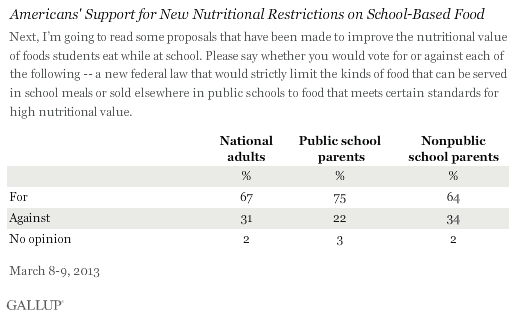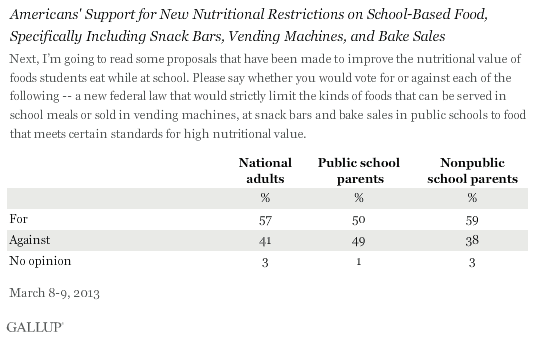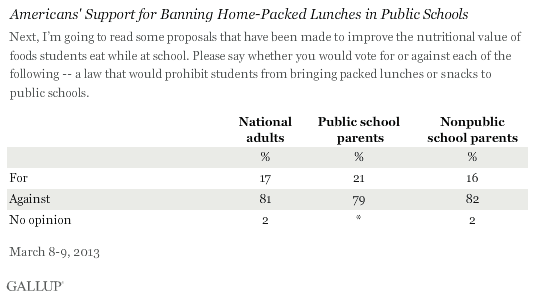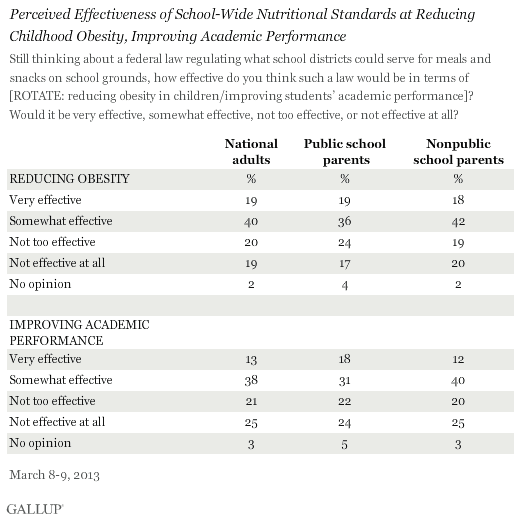PRINCETON, NJ -- Two-thirds of Americans say, if given the opportunity, they would vote for a law that limits food sold in public schools to food that meets standards for high nutritional value. Three-quarters of parents with children currently enrolled in public school and nearly two-thirds of nonpublic school parents favor this proposal.

The U.S. Department of Agriculture (USDA) recently proposed such a policy as part of its mandate to raise school nutritional standards stemming from the 2010 Healthy, Hunger-Free Kids Act. The proposal aims to prevent students from foregoing cafeteria food in favor of "foods of minimal nutritional value" that may be offered in snack bars and elsewhere on school grounds. The public has until early April to comment on the proposed regulations.
The new Gallup poll, conducted March 8-9, also finds a smaller majority of Americans, 57%, favor such laws when the question specifies that the nutritional standards for school meals would also apply to food sold in vending machines, snack bars, and at bake sales. This wording was asked of a separate half sample of respondents.
Notably, public-school parents are less likely than nonpublic school parents to favor the policy when it specifically mentions the outlets for so-called "competitive foods" -- vending machines, snack bars, and bake sales -- that USDA nutritional guidelines would cover.

One Chicago school principal responded to what she saw as an invasion of junk food in school lunch boxes by banning home-packed food at her public elementary school in 2011. This has yet to be widely replicated across the country, but it could someday become the new front line of the battle to promote healthy eating in public schools.
Gallup finds that Americans broadly reject banning home-packed food, even though the proposal is asked in the context of others made "to improve the nutritional value of foods students eat while at school." Eighty-one percent of Americans, including 79% of parents and 82% of non-parents, say they would vote against a law prohibiting students from bringing packed lunches or snacks to school.

Americans Cautiously Optimistic That New Standards Would Work
Americans generally believe a policy regulating the nutritional standards of competitive foods, in addition to school meals, would be effective in combating childhood obesity and improving students' academic performance -- two major goals of the policy. However, relatively few believe it would have a major effect on these goals.
Specifically, 59% say the policy would be effective at reducing obesity in children, including 19% who say it would be very effective. Just over half say it would be effective at improving students' academic performance, including 13% calling it "very effective."

Bottom Line
Americans broadly support federal policies to set nutritional standards for all food served at public schools, and the majority still support these when they are clearly told that, in addition to school meals, the standards would apply to food sold at snack bars, vending machines, and bake sales. In fact, the proposed regulations would not ban school bake sales outright, but would strictly limit the number that fail to meet federal nutritional guidelines.
Americans do not expect the proposed new federal policies regulating what school districts serve for meals and snacks to have a major effect on childhood obesity or student performance, but they believe the standards would help at least somewhat. At the same time, Americans are not amenable to banning home-packed lunches, which would limit parents' and students' ability to themselves determine what the children eat at school.
Survey Methods
Results are based on telephone interviews conducted as part of Gallup Daily tracking March 8-9, 2013, with a random sample of 1,016 adults, aged 18 and older, living in all 50 U.S. states and the District of Columbia.
For results based on the total sample of national adults, one can say with 95% confidence that the margin of sampling error is ±4 percentage points.
For results based on the sample of 524 national adults in Form A and 492 national adults in Form B, the margins of sampling error are ±6 percentage points.
Interviews are conducted with respondents on landline telephones and cellular phones, with interviews conducted in Spanish for respondents who are primarily Spanish-speaking. Each sample of national adults includes a minimum quota of 50% cellphone respondents and 50% landline respondents, with additional minimum quotas by region. Landline telephone numbers are chosen at random among listed telephone numbers. Cellphones numbers are selected using random digit dial methods. Landline respondents are chosen at random within each household on the basis of which member had the most recent birthday.
Samples are weighted to correct for unequal selection probability, nonresponse, and double coverage of landline and cell users in the two sampling frames. They are also weighted to match the national demographics of gender, age, race, Hispanic ethnicity, education, region, population density, and phone status (cellphone only/landline only/both, cellphone mostly, and having an unlisted landline number). Demographic weighting targets are based on the March 2012 Current Population Survey figures for the aged 18 and older U.S. population. Phone status targets are based on the July-December 2011 National Health Interview Survey. Population density targets are based on the 2010 census. All reported margins of sampling error include the computed design effects for weighting.
In addition to sampling error, question wording and practical difficulties in conducting surveys can introduce error or bias into the findings of public opinion polls.
View methodology, full question results, and trend data.
For more details on Gallup's polling methodology, visit https://www.gallup.com/.
